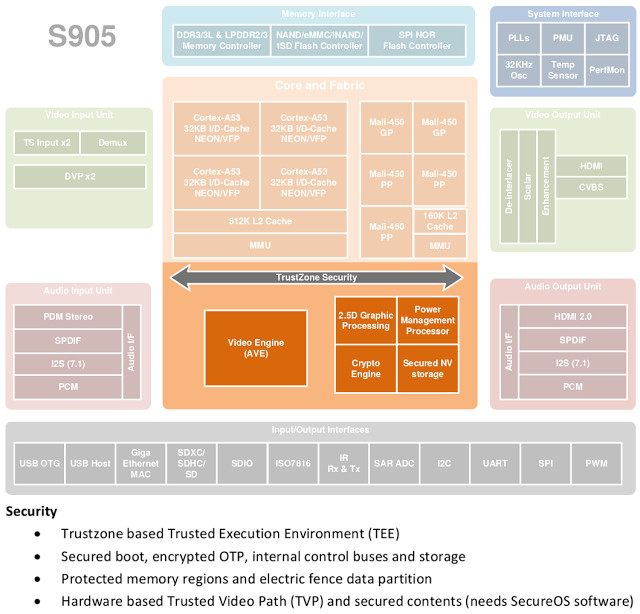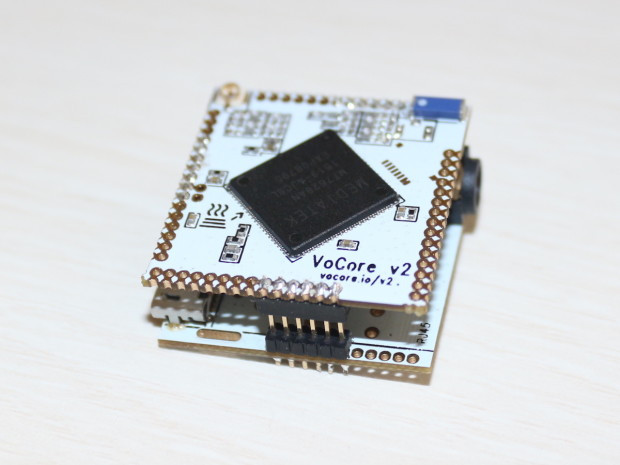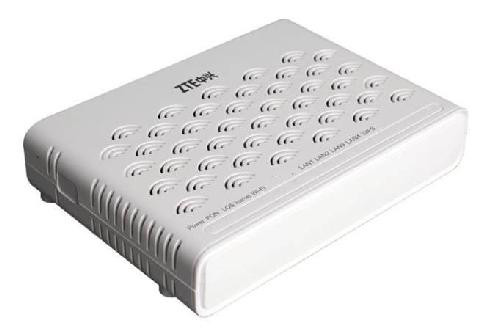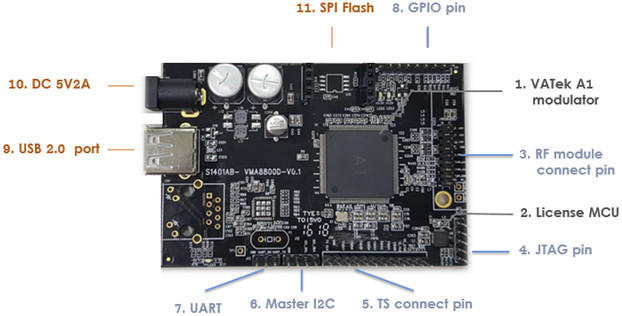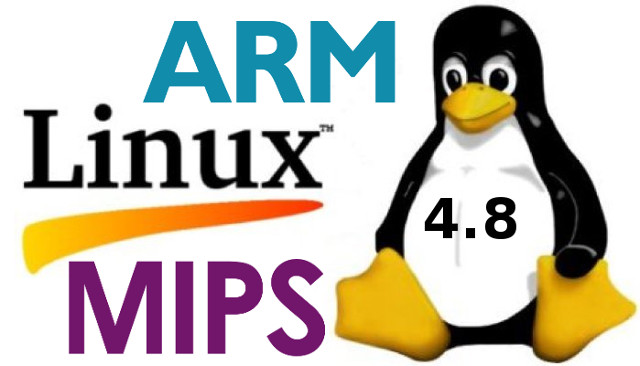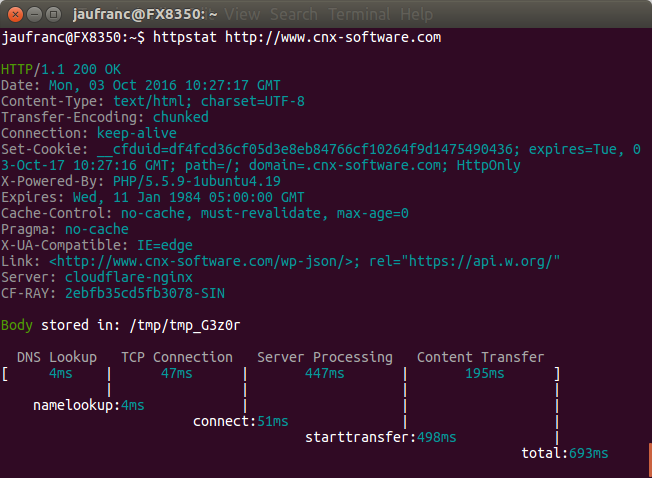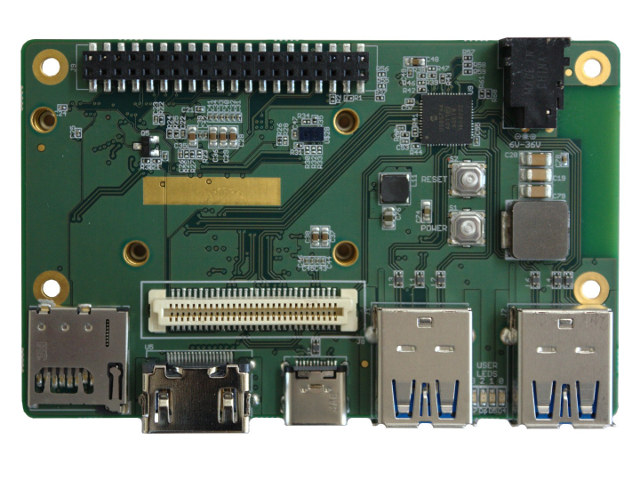Amlogic S905 processor used in many Android TV boxes and ODROID-C2 development board implements ARM TrustZone security extensions to run a Trusted Execution Environment (TEE) used for DRM & other security features. However, Frédéric Basse, a security engineer, worked with others and managed to bypass secure boot in one Amlogic S905 powered Android TV box, namely Inphic i7, but any other device based on the processor would have made the same thing possible. He explains the steps they went through and how they managed to exploit vulnerability to bypass secure boot in a detailed technical blog post. They first started by looking for info in Amlogic S905 datasheet, but most info about TrustZone had been removed from the public version. So not that much help here except a potential address for BOM Root (ROMBOOT_START 0xD9040000). The next step was to connect the UART pins in order to access the […]
VoCore2 WiFi IoT Board Launched with Audio, PoE & “Ultimate” Docks (Crowdfunding)
Vocore WiFi IoT board was popular at its launch in 2014 because affordable WiFi boards with I/Os were not common at the time, and it came with an Ethernet dock making it a complete router within a tiny and cute cube. The developers have been working on VoCore2 (aka Vocore V2) with a faster processor, more memory, a lower power consumption, a better WiFi signal, and more I/Os for several months, and have now launched the board on Indiegogo aiming to raise at least $6,000 for mass production. Vocore2 board specifications: SoC – Mediatek MT7628AN MIPS processor @ 580 MHz System Memory – 128 MB DDR2 Storage – 16MB NOR FLASH, 1x SDXC via I/O pins Connectivity WiFi 802.11n 2T2R up to 300 Mbps with either 2 u.FL connector or 1 u.FL connector + on-board chip antenna (Max signal output >19.5dbm peak) 2x 10/100M Ethernet interfaces via I/O pins I/Os […]
Routers, IP Cameras/Phones & IoT Devices can be Security Risks even with the Latest Firmware, and a Strong Admin Password
I’ve just read an interesting article entitled “who makes the IoT things under attack“, explaining that devices connected to the Internet such as router, IP cameras, IP Phones, etc.. may be used by Botnet to launch DDoS attacks, and they do so using the default username and password. So you may think once you’ve updated the firmware when available, and changes the default admin/admin in the user interface, you’d be relatively safe. You’d be wrong, because the malware mentioned in the article, Mirai, uses Telnet or SSH trying a bunch of default username and password. That made me curious, so I scanned the ports on my TP-Link wireless router and ZTE ZXHN F600W fiber-to-the-home GPON modem pictured below, and installed by my Internet provider, the biggest in the country I live, so there may be hundred of thousands or millions of such modems in the country with the same default […]
V-Bridge Muses Digital TV Modulator Boards Let You Broadcast Your Own TV Channel for $199 and Up (Crowdfunding)
I wrote about VATek VMB8202D Enmoder SoC handling both DVB, ATSC, DTMB and ISDB modulation and H.264 hardware encoding earlier this summer, and at the time, the company also planned to launch a crowdfunding campaign for two open source hardware DTV modulation boards in a couple of weeks. Weeks turned into months, but finally V-Bridge Muses boards and video input & RF daughterboards have now launched on Kickstarter where you can get your own live video broadcasting board for $199 and up. MUSES-α board MUSES-α board is the cheapest of the two boards, and features a header for the RF daughter board, and a USB port to connect to a computer. MUSES-α board specifications: SoC – VATek A1 32-bit RISC modulator chip Storage – SPI flash (unclear whether it can be accessed/modified by user) Modulation – DVB-T/C, ATSC/QAM, DTMB; RF header Video Encoding – N/A (handled by PC via USB […]
Xtream Codes IPTV Panel Review – Part 2: Movie Data Editing, Security, Resellers, Users and Pricing Management
Dear readers, after part 1 of Xtream Codes Panel v.2.2.0 EVO review, here is part 2. I tried hard to get all in two parts, but “to be exhaustive” there will also have to be a part 3… Movie Editing Section As we can see, it’s only possible to assign a movie into a single category, a SELECT BOUQUET Option under the Category would be more then useful. So while Movie Editor Section is useful right now, it still needs improvement. Also taking each movie by hand for editing, after, for example, a Main server crash or changing the Main, is really something, a waste of time. Some of the issues / possible improvements include: No mass edit of movies to bouquets If changing the category of a movie, I found no working method to change in a bulk.. Even if I tried to delete the “content” of a bouquet, […]
Linux 4.8 Release – Main Changes, ARM & MIPS Architectures
Linus Torvalds has officially released Linux 4.8 last Sunday: So the last week was really quiet, which maybe means that I could probably just have skipped rc8 after all. Oh well, no real harm done. This obviously means that the merge window for 4.9 is open, and I appreciate the people who already sent in some pull requests early due to upcoming travel or other reasons. I’ll start pulling things tomorrow, and have even the most eager developers and testers hopefully test the final 4.8 release before the next development kernels start coming 😉 Anyway, there’s a few stragging fixes since rc8 listed below: it’s a mixture of arch fixes (arm, mips, sparc, x86), drivers (networking, nvdimm, gpu) and generic code (some core networking, with a few filesystem, cgroup and and vm things). All of it pretty small, and there really aren’t that many of them. Go forth and test, […]
How to check HTTP Header and Connection Stats from the Command Line
A few days ago, I discussed with somebody whether a file was cached by Cloudflare or not, and this involved getting the HTTP header, and checking for CF-RAY field to see if data is going through one of Cloudflare data centers. This can be done with curl:
|
1 2 3 4 5 6 7 8 9 10 11 12 13 14 15 16 17 18 19 20 21 22 23 24 25 26 |
curl -svo /dev/null http://www.cnx-software.com * Rebuilt URL to: http://www.cnx-software.com/ * Trying 104.28.19.95... * Connected to www.cnx-software.com (104.28.19.95) port 80 (#0) > GET / HTTP/1.1 > Host: www.cnx-software.com > User-Agent: curl/7.47.0 > Accept: */* > < HTTP/1.1 200 OK < Date: Mon, 03 Oct 2016 09:57:17 GMT < Content-Type: text/html; charset=UTF-8 < Transfer-Encoding: chunked < Connection: keep-alive < Set-Cookie: __cfduid=d90ff49c11865e8fda1331c2977559f521475488637; expires=Tue, 03-Oct-17 09:57:17 GMT; path=/; domain=.cnx-software.com; HttpOnly < X-Powered-By: PHP/5.5.9-1ubuntu4.19 < Expires: Wed, 11 Jan 1984 05:00:00 GMT < Cache-Control: no-cache, must-revalidate, max-age=0 < Pragma: no-cache < X-UA-Compatible: IE=edge < Link: <http://www.cnx-software.com/wp-json/>; rel="https://api.w.org/" < Server: cloudflare-nginx < CF-RAY: 2ebf876da273114d-SIN < { [2307 bytes data] * Connection #0 to host www.cnx-software.com left intact |
In the command above, -s stands for silent so that curl does not show the progress meter, -v stands for verbose to show the header, and -o /dev/null is used to discard the packet load. You can also use -I option (fetch the HTTP-header only) with curl, which – if all you need is the HTTP header – provides a cleaner output:
|
1 2 3 4 5 6 7 8 9 10 11 12 13 14 15 |
curl -I http://www.cnx-software.com HTTP/1.1 200 OK Date: Mon, 03 Oct 2016 10:06:51 GMT Content-Type: text/html; charset=UTF-8 Connection: keep-alive Set-Cookie: __cfduid=d4dda8a9ec8370cf0950d26e5faf37cc21475489211; expires=Tue, 03-Oct-17 10:06:51 GMT; path=/; domain=.cnx-software.com; HttpOnly X-Powered-By: PHP/5.5.9-1ubuntu4.19 Expires: Wed, 11 Jan 1984 05:00:00 GMT Cache-Control: no-cache, must-revalidate, max-age=0 Pragma: no-cache Set-Cookie: bb2_screener_=1475489211+1.1.174.2+1.1.174.2; path=/ X-UA-Compatible: IE=edge Link: <http://www.cnx-software.com/wp-json/>; rel="https://api.w.org/" Server: cloudflare-nginx CF-RAY: 2ebf9574c129081d-SIN |
I also came across httpstat Python script recently via n0where, doing much of the same thing, except it also adds transfer statistics. It can be installed by downloading httpstat.py, or better using pip:
|
1 |
sudo pip install httpstat |
Let’s try it with this very […]
Gumstix Nodana 96BCE 96Boards Compatible Baseboard Takes Intel Joule Module
96Boards is an initiative from Linaro, an engineering organization focusing on ARM development, to define some hardware and software specifications for development boards. But since 96Boards specifications are open, Gumstix decided to create the first x86 board compliant with 96Boards CE hardware specifications with Nodana 96BCE baseboard powered by Intel Joule Module. For obvious reasons, this will never be an officially supported 96Boards.org platform. Nodana 96BCE board specifications: SoM – Intel Joule Module based on Intel Atom T5700 or T5500 processor with up to 16GB storage, 4GB RAM. External Storage – 1x micro SD card Video Output – 1x HDMI port USB – 2x USB 3.0 ports, 1x USB 3.0 type C port Expansion Headers 96Boards Low Speed connector with I2C, SPI and UART 96Board High Speed connector with MIPI DSI and USB 2.0 Power Supply – 8 to 18 V (if it follows 96Boards CE specs) Dimensions – 85 […]


